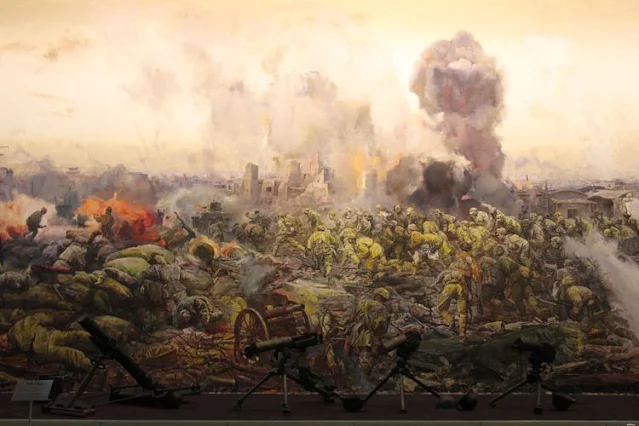Chinese Civil War: The Way of the Battle and the Founding of the PRC

- From August 1945 to the end of 1946, the Nationalists and Communists competed to take over Japanese-controlled territory, build up their strength, and carry out many limited battles while still negotiating for a peaceful settlement.
- During 1947 and the first half of 1948, after the initial success of the Nationalists, the situation turned in favor of the communists.
- The Communists won a series of major victories that began in late 1948 that led to the founding of the People's Republic of China.
Struggle for territory in the Chinese Civil War
Shortly after news circulated that Japan would attack in World War II, the commander of the Communist army, Zhu De, on August 11 ordered his troops to move into Japanese-controlled territory and take over Japanese weapons, ordering Chiang Kai-shek to remain in place. The United States then assisted the Chinese Government by flying many divisions from the southwest to occupy major cities in the east, such as Beiping, Tianjin, Shanghai, and the pre-war capital, Nanjing. The US Navy moved Chinese troops from the south to other coastal cities, and landed 53,000 marines in Tianjin and Qingdao to help disarm and repatriate Japanese troops, but also as a counterweight to Soviet troops in southern Manchuria. Subsequently, US General Douglas MacArthur ordered all Japanese troops only in China to surrender their weapons to the forces of the Nationalist government. They were obedient and sometimes engaged against the Chinese Communist forces.
Immediately after the surrender, the Communists sent cadres and political troops to Manchuria (Northeast China). This was planned long ago. General Lin Biao became commander of the troops, which combined the puppet troops from the previous Japanese Manchukuo regime and began recruiting volunteers. He got most of his weapons from Japanese relics that were taken over by the Soviets. Manchuria is a vast area with a population of 40 million people, the largest concentration of heavy industry and railways in China, as well as large reserves of coal, iron, and many other minerals. The Soviet Union promised the Nationalist Government that it would withdraw its occupying forces within 90 days of Japan's surrender and return the territory to China. However, the Nationalists wanted to control Manchuria, which was vital to China's future as a world power. Lin Biao's army then tried to block the entry of the Nationalist troops by destroying the railway line and seizing the area around the port of entry. Shortly thereafter, the two sides were caught in a fierce battle for entry into Manchuria, although negotiations were ongoing in Chongqing between Mao Zedong and Chiang Kai-shek for a peaceful settlement. Soviet soldiers avoided direct involvement in the Chinese Civil War, but they dismantled many industrial machines and shipped them to the Soviet Union along with hundreds of thousands of Japanese prisoners of war.
In late 1945, the Nationalists stationed some of their best US-trained troops in southern Manchuria, as far north as Mukden (now Shenyang), a strategic railway hub where Nationalist troops were transported by air. Meanwhile, the communist power spread in various provinces from west to sea. They controlled most of the railway north of the Longhai Line, which was a vital supply line for the Nationalist army in the Tianjin-Beiping area and in Manchuria. The Nationalist government controlled large areas to the south and west and reestablished its authority in the wealthy provinces of the lower Yangtze valley and in several important cities in northern China. They also took over civilian control in Taiwan. The withdrawal of the occupying Soviet troops in March–April 1946 also sparked territorial struggles. Nationalist forces occupied Mukden (Shenyang) on March 12, while the Communists consolidated their grip across northern Manchuria. After government forces captured Changchun on May 23, a 15-day ceasefire was declared in Manchuria from June 6 to June 22. However, fighting escalated elsewhere, as government and Communist forces clashed in Jehol (Chengde), northern Kiangsu (Jiangsu), northeastern Hopeh (Hebei), and southeastern Shantung (Shandong).
Founding of the People's Republic of China
The People's Republic of China (PRC) is the form of government in the center of mainland China, created by Chinese Communist leader Mao Zedong in his declaration on October 1, 1949. The announcement ended the Chinese Civil War between Communists and Kuomintang Nationalists. The formation of the PRC also completes a long process of government turbulence in China that began with the Chinese Revolution in 1911. The fall of mainland China to communism in 1949 led the United States to suspend diplomatic relations with the PRC for decades, as reported by the Office of the Historian.
ALSO READ OTHER NEWS OTHER NEWS FROM VARIOUS COUNTRIES ONLY AT:
HAPPY READING ^_^ DON'T FORGET TO LIKE AND SHARE YES ^_^